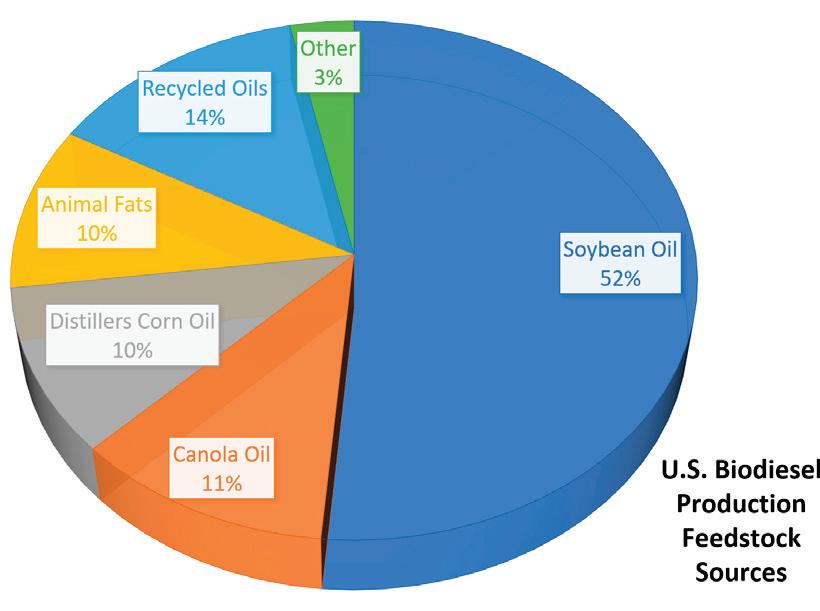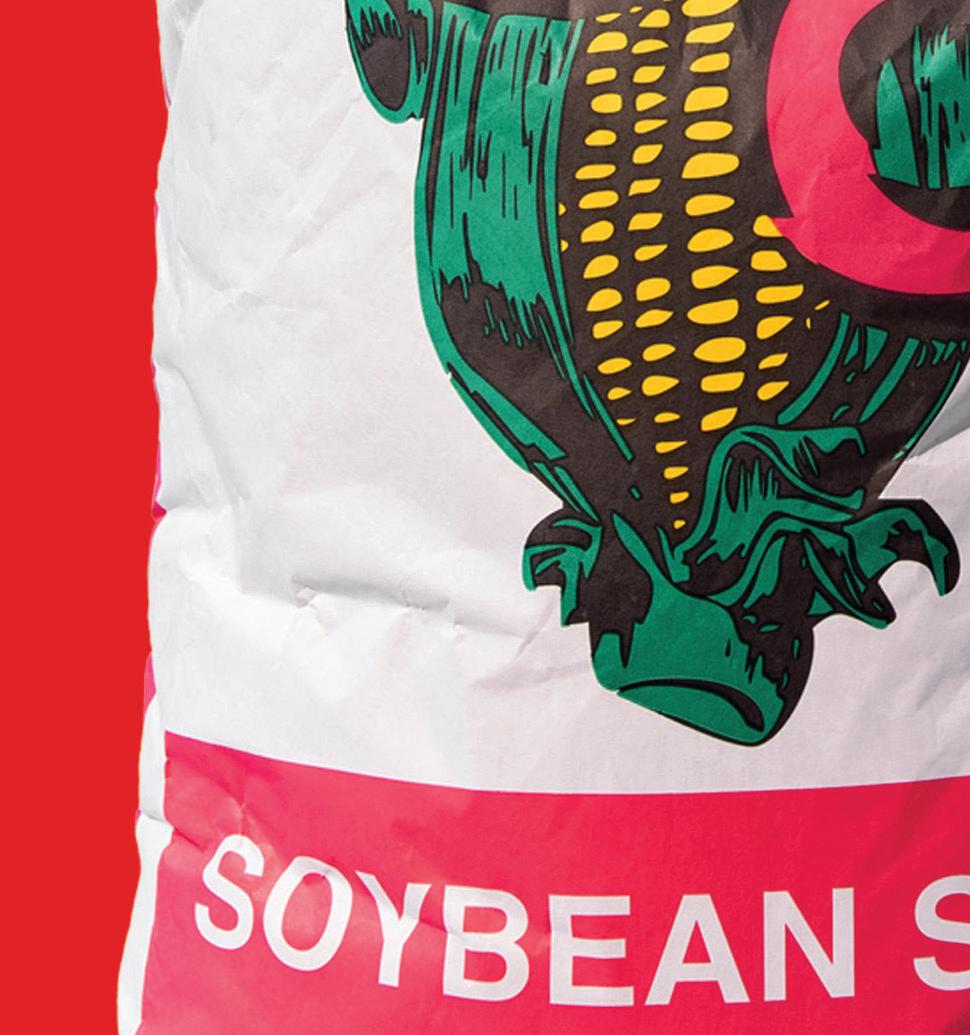
































There are plenty of look-alike seed treatments out there, but don’t let them fool you. With CruiserMaxx® Vibrance® Beans* you get the industry-leading combination of fungicides and insecticide. Nothing else protects your soybeans while boosting root health and yield with the same kind of power. To learn how that helps you win at harvest, talk with your local Syngenta retailer or visit SyngentaUS.com/CMVB.










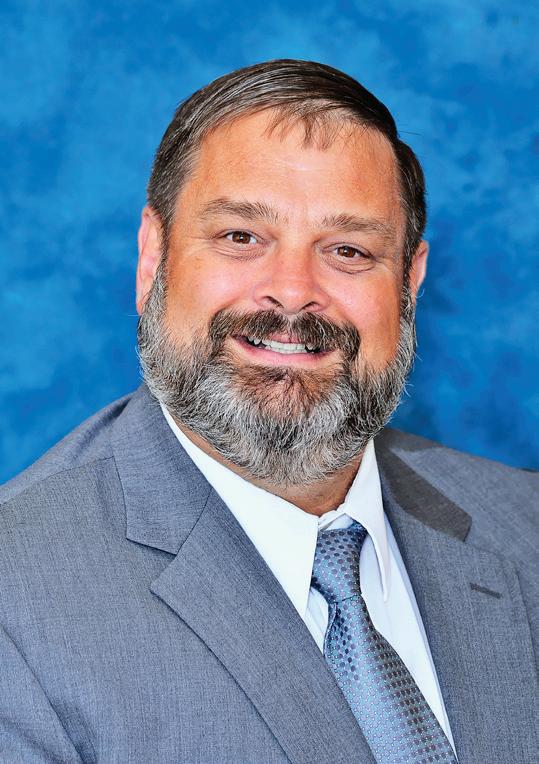
Todd Hesterman
Ohio Soybean Association Chairman Henry County soybean farmer
In early October, I had the opportunity to testify before the ‘Toward a Cleaner Lake Erie’ legislative working group at Ohio Northern University. That is a busy time of year
for me, like many farmers, but I knew that it was my responsibility to ensure that this group heard from us.
Under the leadership of Senate Agriculture Committee Chairman Bob Hackett & House Agriculture Committee Chair Brian Hill, this legislative working group came together to hear testimony from farmers in the Western Lake Erie Basin. A few months ago, Gov. Kasich issued an Executive Order that would declare eight watersheds in the Western Lake Erie basin as distressed and would regulate commercial fertilizer, which the Ohio Soybean Association opposed. The distressed designation would trigger several new rules for farmers in the watershed, including a requirement to have a certified nutrient management plan.

I, myself, went through the process of getting a nutrient management plan done and encourage all farmers to have one. However, a practical nutrient management plan must be flexible enough to allow for quick and seamless updates as new information and data become available.
From my experience testifying, I learned that the legislature is committed to bringing all groups, not just farmers, to the table to create a systematic approach to solving Ohio’s water quality issues. The Ohio Soybean Association remains committed to making sure Ohio’s soybean farmers voices are heard. It is imperative that we continue to engage our legislative representatives, so they understand what exactly this would mean to the farming community in Ohio.
Farmers are, and have always been, good stewards who want to do the right thing. Protecting Lake Erie is a priority for us and that’s why we voluntarily adopt conservation practices on our farms every year. We look forward to working with the legislature and future administrations on finding solutions that are both economically viable to Ohio’s farmers and based on sound, scientific research.
–Todd Hesterman
President
Allen Armstrong, Clark County
First Vice President
Scott Metzger, Ross County
Vice President
Ryan Rhoades, Marion County
Treasurer
Kerrick Wilson, Preble County
Secretary
Jennifer Wilson-Oechsle, Van Wert County
Chairman
Todd Hesterman
Trustees
Jerry Bambauer, Auglaize County
Trish Cunningham, Knox County
Bret Davis, Delaware County
Adam Graham, Logan County
Caitlyn Heimerl, Industry A liate Ex-O cio
Patrick Knou , Shelby County
Je Magyar, Ashtabula County
Je McKanna, Hancock County
Cindy Parker, Miami County
Derek Reusser, Holmes County
Je Roehm, Highland County
Luke Ryan, Lucas County
Andy Stickel, Wood County
American Soybean Association
Board Representatives
Jerry Bambauer
Bret Davis
Scott Metzger
Staff Credits
Kirk Merritt-Publisher
Jennifer Coleman-Editor
Julia Brown-Contributing Editor/Sta Writer
Brent Warren-Art Director
Barry Falkner-Photo Quality/Proofer
Tony Green-Advertising Production
Ohio Soybean news is published six times a year by the Ohio Soybean Association, 918 Proprietors Rd., Suite A, Worthington, OH 43085. Phone: 614-476-3100. For address corrections contact Ohio Soybean News at 918 Proprietors Rd., Suite A, Worthington, OH 43085.
Web address: www.soyohio.org E-mail: cdeboard@soyohio.org
Comments and statewide news articles should be sent to the above address. Advertising space reservation must be made by the rst of the month preceding publication. In consideration of the acceptance of advertisement, the agency and the advertiser must, in respect of the contents of the advertisement, indemnify and save the publisher harmless against any expense arising from claims or actions against the publisher because of the publication of the content of the advertisement.
For Advertising Sales Contact:
Matt Herman- (612) 812-5833
matt.herman@dtn.com



Join us for the 2018 Ohio Grain Farmers’ Symposium on December 18 at the Nationwide & Ohio Farm Bureau 4-H Center in Columbus, Ohio. This is an opportunity for grain farmers from across the state to hear about the latest issues impacting their operations and learn how advocacy groups are fighting for farmers’ best interests.
The Ohio Soybean Association and Ohio Corn & Wheat Growers Association will also be holding their annual meetings in conjunction with the symposium.
Hear from business and industry leaders and join your fellow farmers for:
▶ Top-level speakers — On the most critical topics for farmers including water quality, legislative updates,
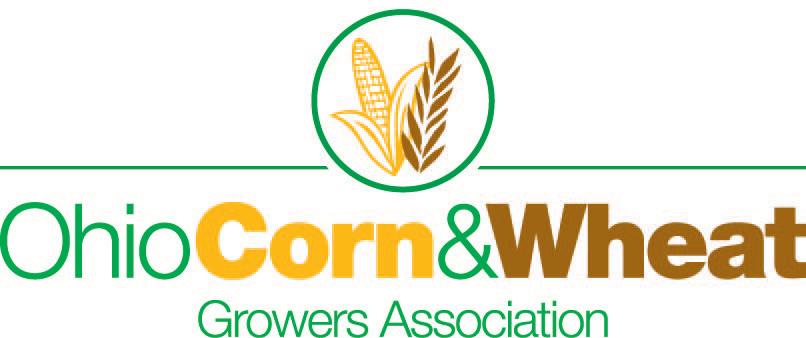
biotechnology, and more
▶ Powerful discussions — To get new insights for 2019 and beyond
▶ Annual meetings — Make your voice heard as a member
▶ Visit with representatives who serve the agriculture industry
Registration is open now. Register today by calling the Ohio Corn & Wheat Growers Association at 740201-8088 or by registering at www. ohiograinfarmerssymposium.org. u


The American Soybean Association views the new trade deal as favorable.
The Administration’s announcement that it has reached an agreement with Canada, bringing to fruition a trilateral trade agreement including Mexico, is welcome news for soy growers. Once approved by Congress, a finalized U.S.-Mexico-Canada Agreement (USMCA) will bring stability
back to the North American markets. Under NAFTA, U.S. soy exports to Canada and Mexico were almost $3 billion in 2017, and U.S. soy exports to Mexico have grown four-fold under the agreement. Mexico is now the second largest export market for U.S. soybeans and meal. Additionally, roughly $43 billion of agriculture products are exported to Canada and Mexico every year.
ASA President and soybean grower from Keota, Iowa, John Heisdorffer said, “Our soybean harvest this year is large, and we are facing great uncertainty in China, so a modernized NAFTA is timely and beneficial for our farmers and rural communities.”
USMCA, will help stabilize the U.S.’s two neighboring export markets for

NAFTA, which was established in 1994, created a trilateral trade bloc in North America.
growers, something that the American Soybean Association (ASA) has been requesting of the Administration. And, this news follows the recent announcement that the U.S. had signed a new free trade agreement with Korea and that negotiations are in progress with Japan.
“With USMCA, KORUS, and other agreements in sight, we are hopeful that a negotiated solution to the China tariffs could be in sight,” commented Heisdorffer. u
Courtesy of the American Soybean Association


The U.S. Department of Agriculture (USDA) released details of its aid package to help offset the impact of tariffs, which includes a Market Facilitation Program that will make payments to producers of soybeans and six other farm commodities for the 2018 crop. The program also includes an increase of USDA purchases of various impacted U.S. agricultural products, and a Trade Promotion Program to develop foreign markets for American agricultural exports.
The Ohio Soybean Association (OSA) welcomes the support from the Administration and details of the how that support will be distributed. OSA also reiterates the need for a long-term solution that protects soybean farmers and opens export markets.
“We’re pleased to see the details of


the aid package released in a timely manner so there can be some certainty for farmers moving into the harvest season,” said Allen Armstrong, OSA president and Clark Co. soybean farmer. “However, this is a short-term fix and we continue to advocate for free and open markets with our national affiliate, the American Soybean Association, and for a resolution to the trade dispute with our biggest international customer.”
USDA’s Farm Service Agency will administer the Market Facilitation Program for payments. Farmers can apply for support through January 15, 2019. Applications will be available online at www.farmers.gov/mfp.
The value of the 2018 soybean crop has been under increasing pressure ever since tariffs were imposed in early July, with prices dropping
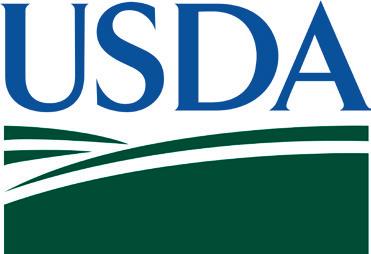
approximately $2 per bushel nationally. In the last two months, USDA has raised its estimate for soybean production in 2018 to a record 4.6 billion bushels, reduced its estimate for soybean exports in the 2018-19 marketing year by 230 million bushels, and projected an 82 percent increase in soybean carryover stocks to 785 million from 430 million bushels by September 2019.
In 2017, Ohio was the sixth largest producer of soybeans in the U.S. with 4.8 million acres planted and 263 million bushels. The value of the Ohio soybean crop is currently $2.5 billion and over 60 percent of Ohio soybeans go to international markets. u
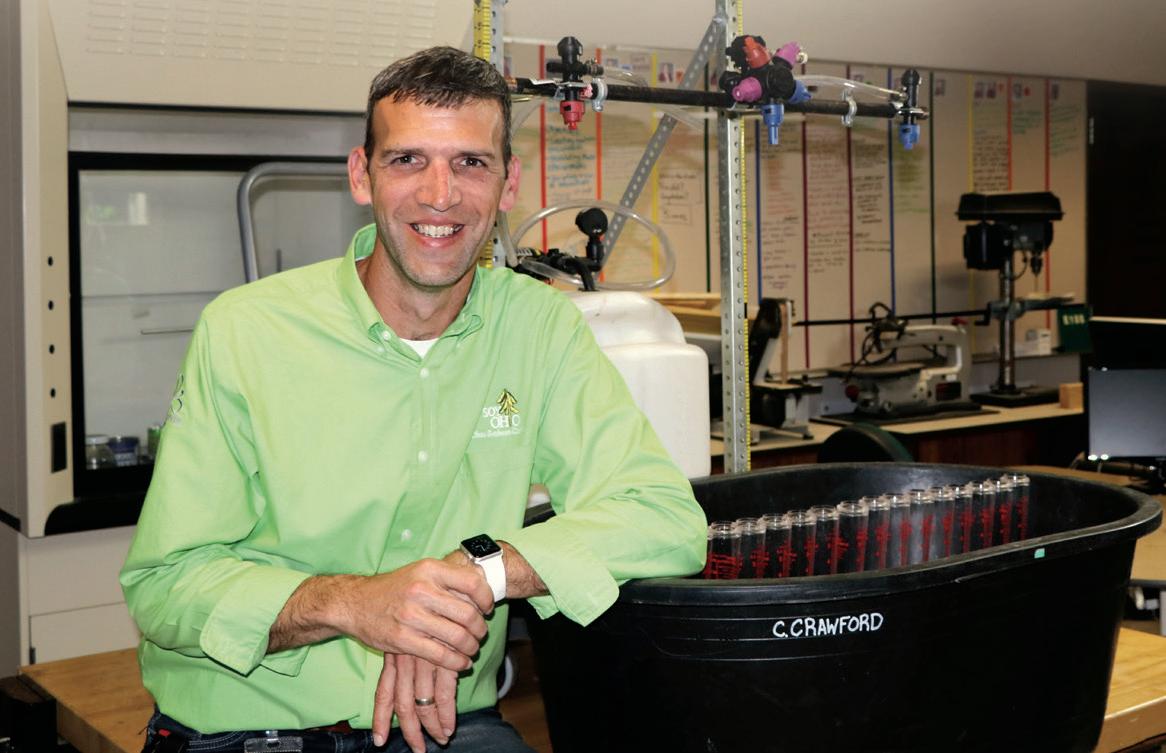
CHUCK CRAWFORD | TEACHER | MENTOR | DUBLIN JEROME HIGH SCHOOL, DUBLIN, OH


Chuck Crawford teaches advanced classes in environmental science and research at Dublin Jerome High School. He believes it’s important for students to see science applied in real-world settings. Utilizing soils, biogeochemical cycles, nutrient management, robotics, plant genetics and more to explore agriculture, he encourages his students to think for themselves. In the process, they learn about modern agriculture and become smarter consumers, too. Crawford appreciates the funding and support from the Ohio Soybean Council and checkoff that make education programs like GrowNextGen possible. To learn more about GrowNextGen, visit grownextgen.org.
DO NOT APPLY DICAMBA HERBICIDE IN-CROP TO SOYBEANS WITH Roundup Ready 2 Xtend® technology unless you use a dicamba herbicide product that is specifically labeled for that use in the location where you intend to make the application. IT IS A VIOLATION OF FEDERAL AND STATE LAW TO MAKE AN IN-CROP APPLICATION OF ANY DICAMBA HERBICIDE PRODUCT ON SOYBEANS WITH Roundup Ready 2 Xtend® technology, OR ANY OTHER PESTICIDE APPLICATION, UNLESS THE PRODUCT LABELING SPECIFICALLY AUTHORIZES THE USE. Contact the U.S. EPA and your state pesticide regulatory agency with any questions about the approval status of dicamba herbicide products for in-crop use with soybeans with Roundup Ready 2 Xtend® technology. ALWAYS READ AND FOLLOW PESTICIDE LABEL DIRECTIONS. Soybeans with Roundup Ready 2 Xtend® technology contain genes that confer tolerance to glyphosate and dicamba. Glyphosate herbicides will kill crops that are not tolerant to glyphosate. Dicamba will kill crops that are not tolerant to dicamba.Roundup Ready 2 Xtend® is a registered trademark of Monsanto Technology LLC used under license.
Always follow grain marketing, stewardship practices and pesticide label directions. Varieties with the Glyphosate Tolerant trait (including those designated by the letter “R” in the product number) contain genes that confer tolerance to glyphosate herbicides. Glyphosate herbicides will kill crops that are not tolerant to glyphosate.
Pioneer ® brand products are provided subject to the terms and conditions of purchase which are part of the labeling and purchase documents.
TM , ® , SM Trademarks and service marks of Dow AgroSciences, DuPont or Pioneer, and their affiliated companies or their respective owners. © 2018 PHII. DUPPSY18035_VC2_OSN


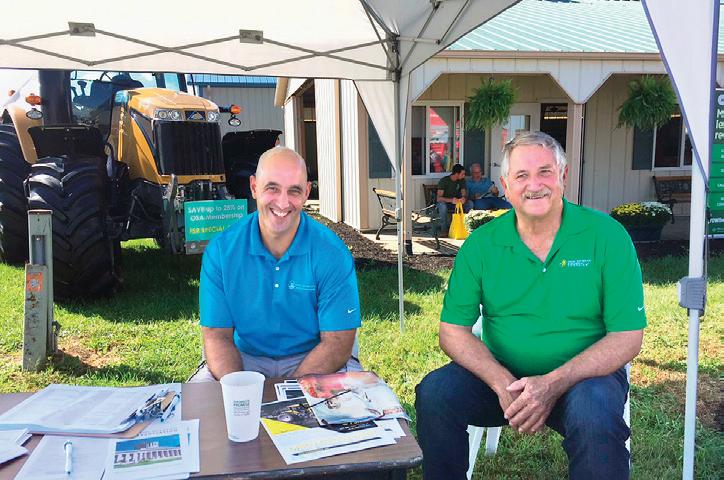
The 56th Farm Science Review drew 108,074 visitors, many of whom stopped by the Ohio Soybean building located at the intersection of Friday Ave. and Tractor St. The Ohio Soybean Association (OSA) recruited a record number of new members this year. OSA staff members and board members greeted visitors with free cups of coffee and were able to explain the benefits and importance of belonging to a grassroots organization like OSA. OSA enlisted the help of several students involved in the Agricultural Communicators of Tomorrow at The Ohio State University to walk the grounds and engage with young people about becoming Student and Young Adult members.
OSA’s First Vice President Scott Metzger, a soybean farmer from Ross County, spoke to “In Ohio Country Today” about OSA’s current projects and priorities. Visitors also got the chance to ask staff and board members about current issues affecting soybean farmers, like water quality and tariffs, and how OSA is working to advocate for Ohio’s soybean farmers at both the state and national levels.
“We’re very excited about the work OSA is doing and it’s always great when we have the chance to talk directly to Ohio’s farmers about our priorities,” said Kirk Merritt, executive director of OSA. “I’m proud of our staff and farmer board members for helping us reach a record for new members.” u


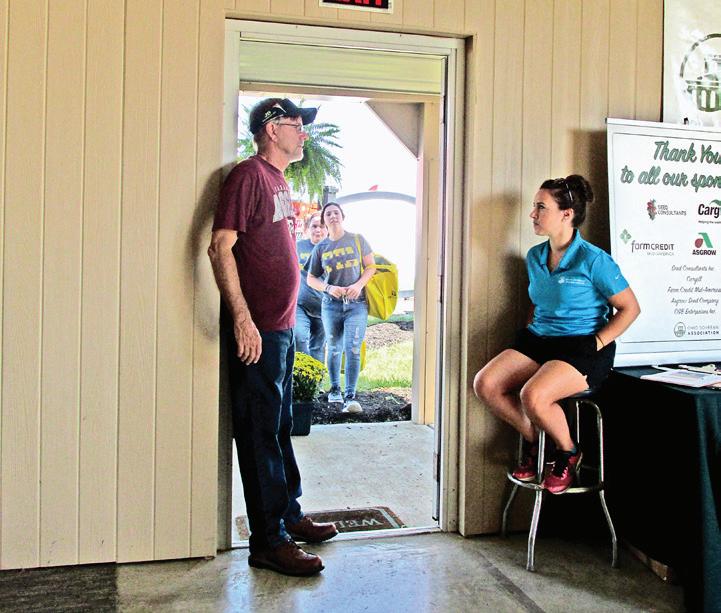
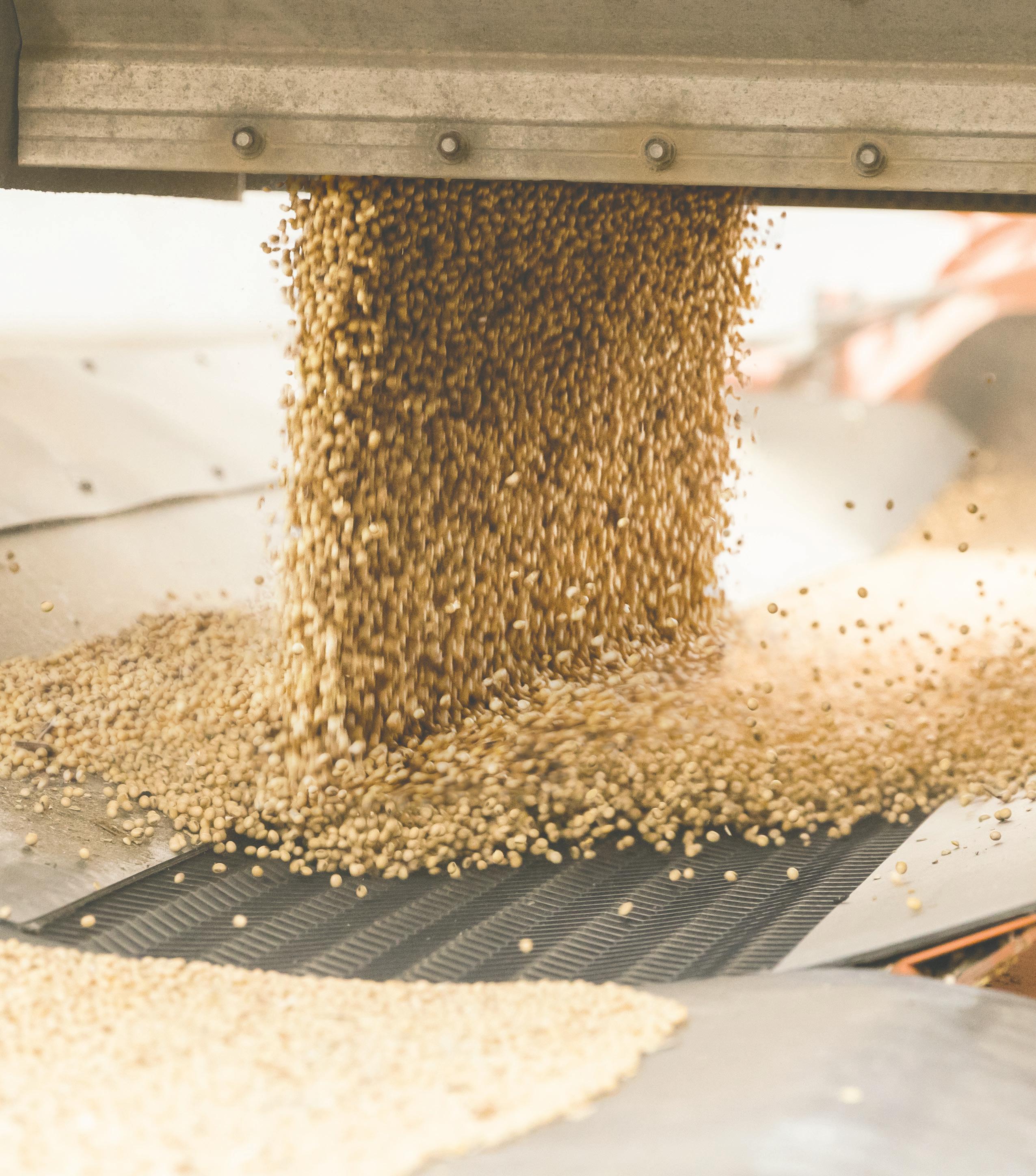


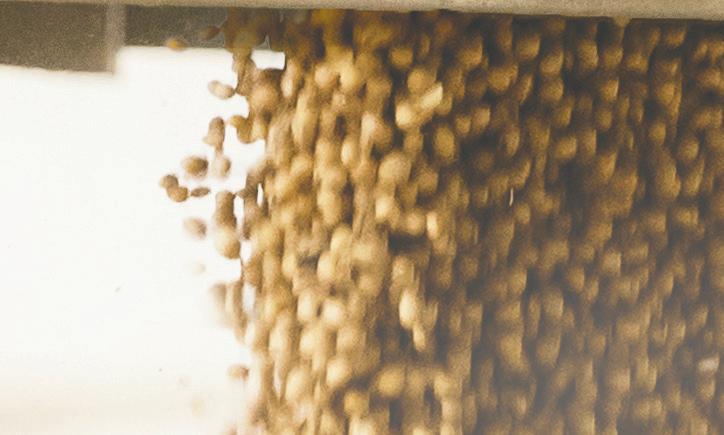








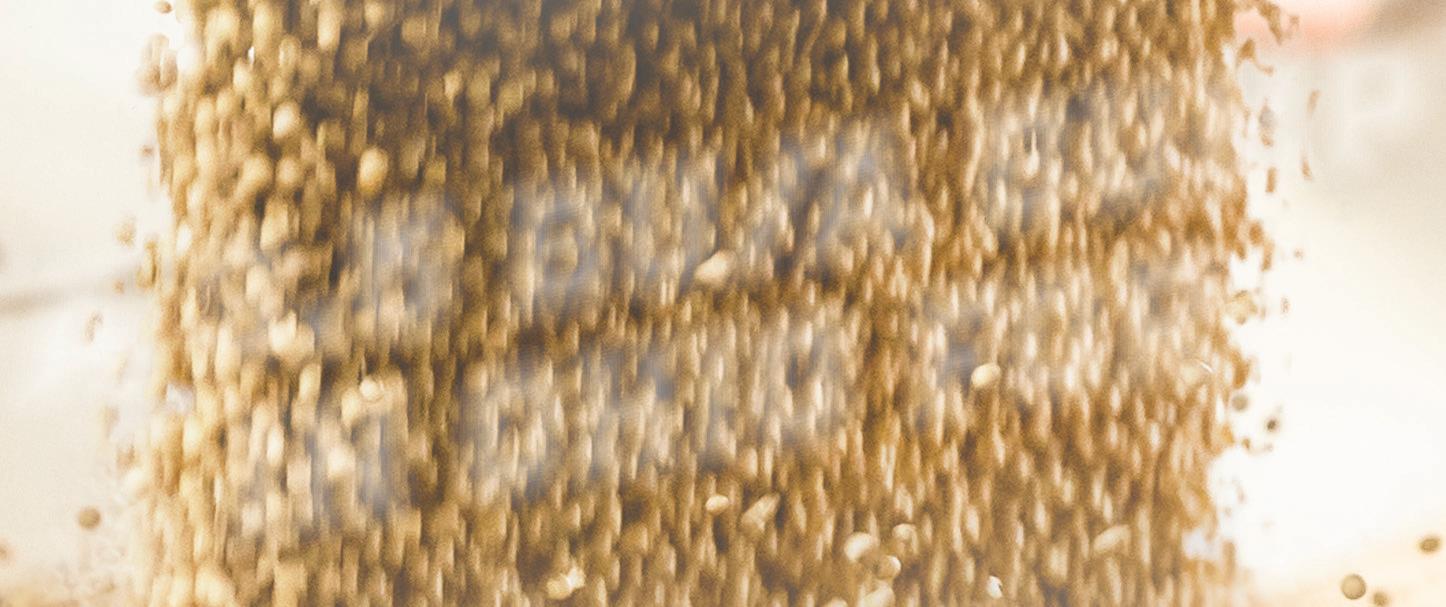

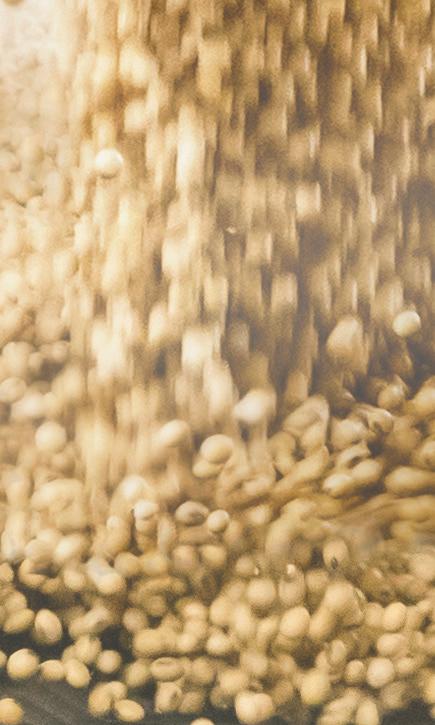




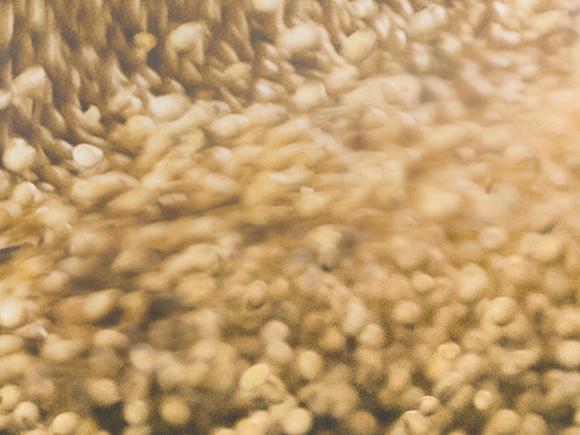

































The Ohio Soybean Association would like to thank its 2018 Corporate Sponsors

HARVESTER LEVEL CONTRIBUTOR LEVEL


SUPPORTER LEVEL
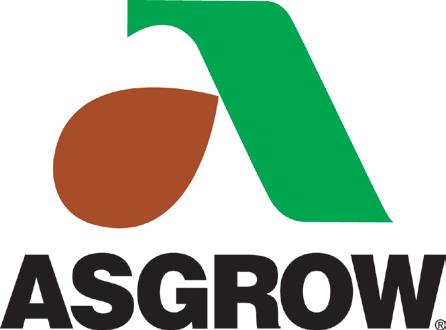

If you are interested in supporting the Ohio Soybean Association as a Corporate Sponsor in 2019, please contact Emilie Regula Hancock at eregula.hancock@soyohio.org.





OSA Would Also Like to Thank its Lifetime Members for Their Support.


Dave Allmandinger
Tony Anderson
Andrew Armstrong
Gary Bach
Gene Baumgardner
Curt Bibler
Jason Boeckmann
Wayne & Bob Cannon
Tim Carles
Matt Chatlain
Dale Circle
Joshua Clunk
Chris Collett
William & Jeff Coppess
Bret Davis
Jason Davis
Keith Derck
Duane, Alan & John Dick
Dave Dotterer
Matthew Durbin
Jay Fisher
Bill Frankart
Chad Gargas
Jon & Scot Haar
Denny Hall
Mark Hoffman
Terry Howell
Ellen Joslin
Robert Keehner

David Martin
Terry McClure
Daniel Michael
Robert Miller
Hoover Farms Partnership
Stephen Pidgeon
John Ralph
John Rethmel
Roger Rupp
John Sawyer
Michael Scherger
Donn Scheufler
Joseph Steiner
Robert Stilwell
Kristopher Swartz
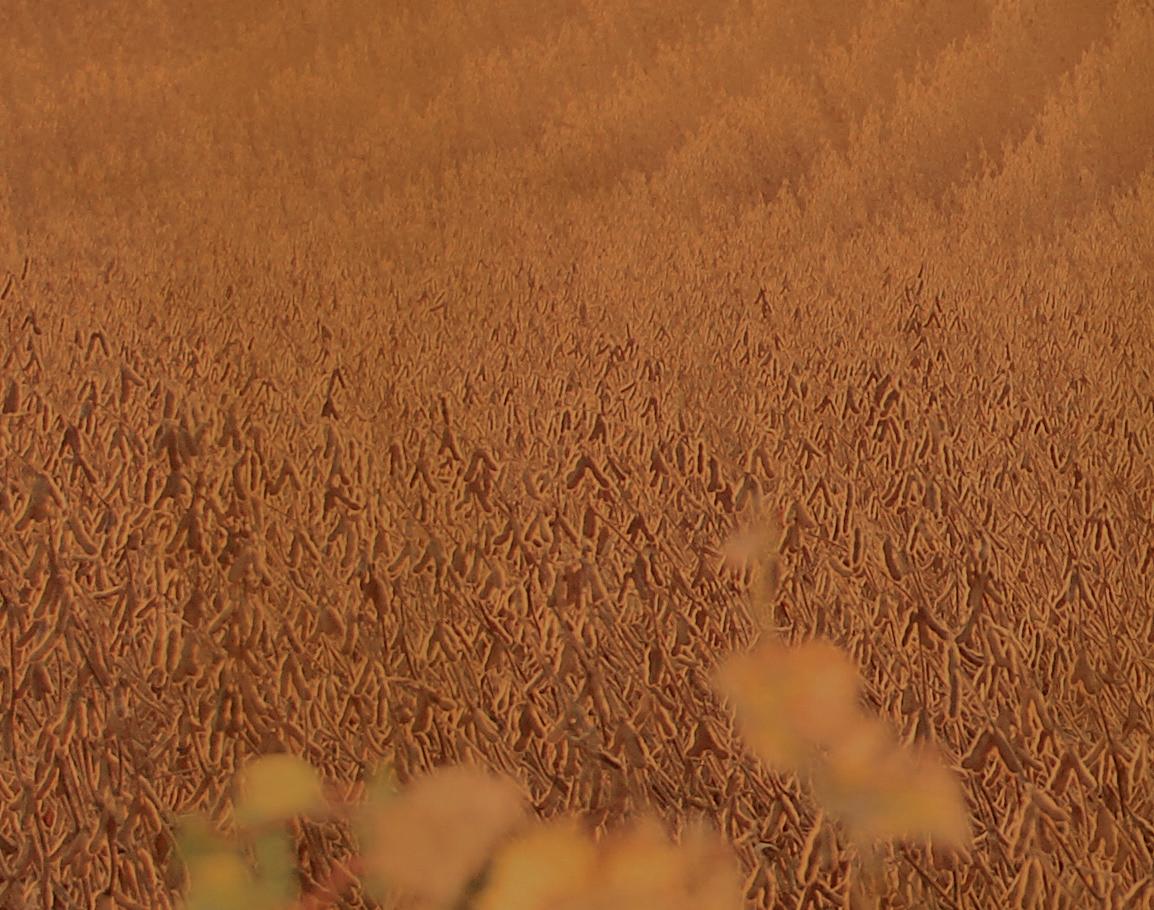
Ed Lamalie
John Landis
Roger Lange
Dan & Nate Liskai
Paul Ludwig
Thomas Terrell
Bradley Terrill
Michael Tobe
Douglas Utz
Jim VanTilburg
Luke Vantilburg
Mark Wachtman
Geraldine Walker
Kirk Walker
Albert Walton
Andrew Whiteleather
Dennis Wischmeyer
Russell Zeedyk
Aaron Zimmerman
Shoemaker-Webb AgriBusiness LLC

Neer Farms
Carraher Farms Partnership

Basinger Farms Inc


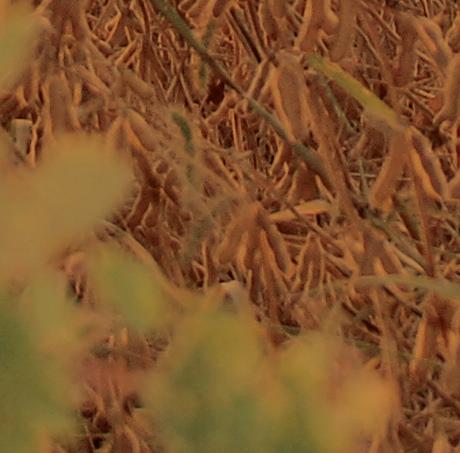
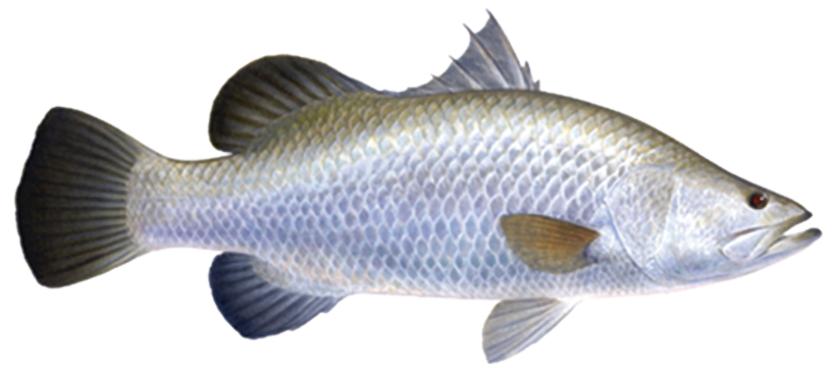
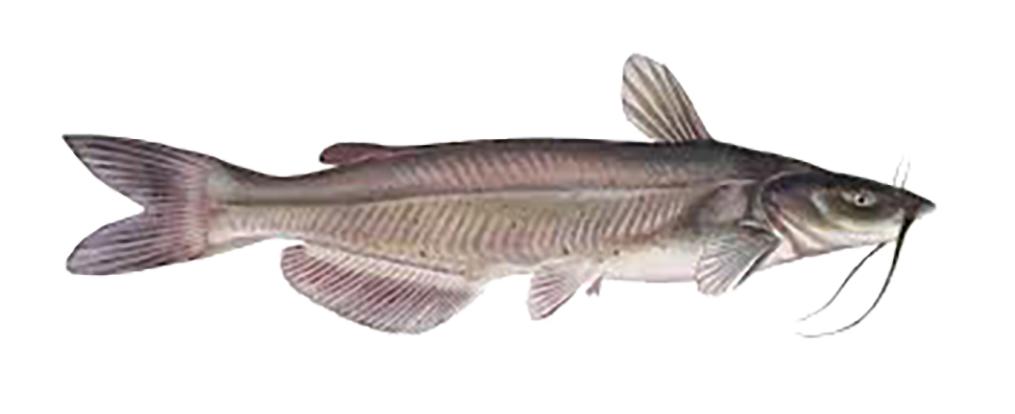















In 2017, the Ohio Soybean Council put your checkoff dollars where hungry fish mouths are, partnering with Battelle and Kentucky State University to develop and evaluate an innovative new soybean meal that could revolutionize fish farming. Our patented EnzoMeal™ technology removes anti-nutritional factors (ANF) from conventional soybean meal to deliver a healthy, sustainable and economical alternative to traditional fish feeds. That’s valuable news for Ohio soybean growers because aquaculture is the fastest-growing sector in food production.
Discover all the ways state soybean checkoff dollars are working for Ohio growers at SoyOhio.org.

All stories written by Irene Gentzel

As farming continues to change, it’s more important than ever for growers to stay on top of the latest agronomic research, technology trends and water quality best practices. That’s why the Ohio Soybean Council developed Field Leader, an online resource to give you access to the latest soybean checkoff research and water quality information to enhance your operation. To learn more about Field Leader and how checkoff-funded research is helping Ohio soybean farmers every day, visit ohiofieldleader.com.

By Irene Gentzel

Just the mention of pigweeds can quickly put dread into farmer and researcher alike. Why? These weeds possess two traits that spell disaster for growers: excessive seed production and rapid herbicide tolerance. Controlling the spread and incidence of these plants is therefore very difficult and requires vigorous management strategies.
Mark Loux, professor of horticulture and crop science at The Ohio State University, is leading an OSC-funded campaign to increase awareness among Ohio farmers about two particular pigweeds: Palmer amaranth and waterhemp. “Our four big weeds in the Midwest are giant ragweed, marestail and those two pigweeds,” Loux says.
Loux realizes that communication and education are key to helping farmers prevent these aggressive weeds from taking over their fields. Together with Extension educators, Loux distributes posters, videos and thousands of packets every year with information on how to identify and prevent the spread of Palmer amaranth and waterhemp weeds.
“Once we have it come into a field or
an area, what we try to do is a community effort, where it’s identified, and we get everybody together and tell them ‘You don’t want this weed in the area,’ ” he says. Sometimes a grower may allow a few lone plants to set seed, thinking they can be taken care of the following year. “If you take that approach with waterhemp once, you’re sort of about halfway into a massive problem. And then you do it again and you’re just sort of game over. You just have this massive mess,” Loux says.
Control efforts can be very difficult, though. “Palmer has to be treated when it’s very small post-emergence, even smaller than waterhemp,” Loux says. In addition to this small window for herbicide treatment, pigweeds are notorious in their ability to become immune. “They tend to develop resistance to whatever is used on them after about three to four times,” Loux says. To address this, he and his collaborators are helping growers across Ohio determine how resistant their pigweeds are to different types of herbicides to save them time and money the following season. “The problem with beans is we’ve used
Each female Palmer amaranth plant produces hundreds of thousands of seeds, so just a single weed can quickly turn into a severe problem.
up more of our post-emergence options than we have in corn, so it’s just more difficult,” he says.
Prevention, Loux notes, is still the best strategy to managing these pigweed problems, even if it means walking the fields and pulling the weeds out by hand. “Usually the first time someone sees a new weed is going to be late season when it escapes their program. So you need to do some extra scouting with binoculars or whatever to check the field in August to see what’s out there.” Taking this advice, in addition to implementing targeted herbicide treatments based on resistance testing of previous season weeds, will greatly reduce the risk of new pigweed infestations across Ohio.
More information about pigweeds can be found at: https://bit.ly/2O3ojPD. u
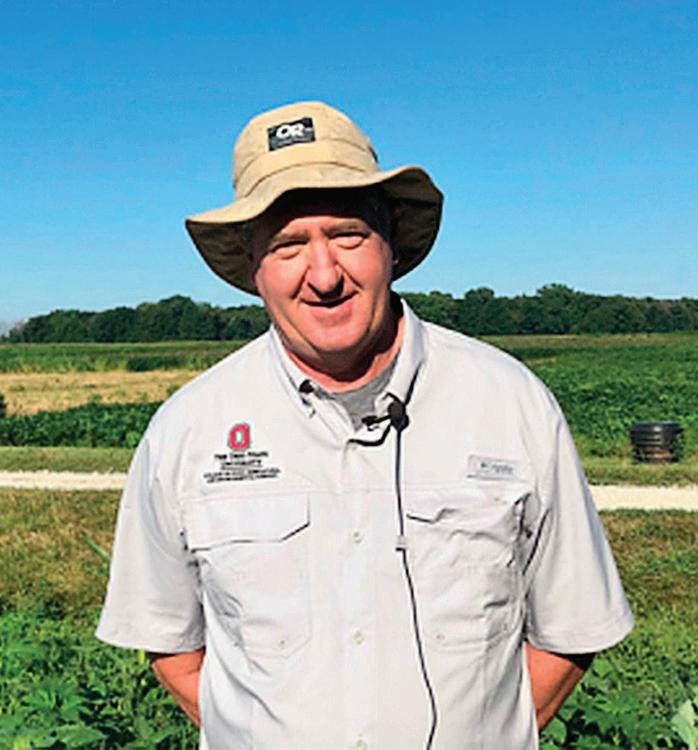
OSU's Mark Loux is working hard to help increase pigweed awareness among Ohio’s farmers.




The Ohio Soybean Council works closely with The Ohio State University to keep you on the leading edge of soybean production. Your success is the mission of OSU’s Center for Soybean Research. You have a voice there, too. When growers asked if fertilizer amounts used two decades ago were still relevant in today’s fields, OSU’s researchers went to work to find the answer.




By Irene Gentzel
Developing new soybean cultivars resistant to disease and pests is not easy. It often entails years of careful work to determine the function of genes in the soybean plant, of which there are over 60,000.
A conventional method for determining gene function in plants is to simply delete the gene from the genome. But this process can take months or even years to complete. Since this timeframe is not practical, researchers have started using viruses for short-term gene inactivation. While the results can’t be passed on like with the traditional method, the Virus-Induced Gene Silencing system (VIGS) can be used to
quickly determine a gene’s importance for resistance.
Feng Qu, a virologist at The Ohio State University, is the go-to person for soybean researchers who want to utilize VIGS. “Our research is not just to silence the gene … We also want to see if the plant becomes more or less susceptible to pathogens like Phytophthora sojae or aphids,” Qu says.
Qu recently collaborated with entomologist Andy Michel on a checkofffunded project to find resistance genes against soybean aphids. Out of the seven genes they silenced, one paid off.
“The plants that were originally resistant to aphids became more susceptible, so we know we hit the right gene,” Qu says. Now, Qu has to confirm this result using the more conventional method of deleting
the gene from the soybean’s DNA. If the genetically modified plants show the same increase in susceptibility to aphids, the identified gene can be placed on the high priority list for developing new aphidresistant soybeans. u

















By Irene Gentzel
Farmers and urban folk alike have become well acquainted with the brown marmorated stink bug (BMSB). Originally from Asia, this invasive species of stink bug has quickly established itself in the United States as a significant soybean pest. The adult BMSB overwinters in homes and buildings before moving to the lush, green soybean fields in spring and summer.
Unfortunately, BMSB isn’t the only stink bug pest Ohio soybean growers must deal with. Eight other stink bug varieties infest soybeans in addition to common pests like grasshoppers and bean leaf beetles. Because there are so many potential insect threats to soybean yields, growers have no choice but to closely monitor their fields to ward off infestations.
Scouting for bugs in a soybean field can be quite a job. Typically, it involves wading through the plants with a large
sweep net to brush off the unsuspecting insects. These insects then have to be sorted and counted to determine if a certain threshold has been met to consider the field infested.
Kelley Tilmon, an entomologist at The Ohio State University, always keeps growers in mind for her research projects. Funded by the Ohio Soybean Council, Tilmon is researching whether sticky cards originally developed for orchards will also work reliably in soybean fields to trap insect pests. “We are always looking for ways to make monitoring for insects easier,” Tilmon says. For the BMSB, these cards are coated with a specific pheromone lure that attracts stink bugs from the surrounding area. Since the sticky cards are mounted on posts at various locations in the field, the idea is that a farmer can walk by and determine at a glance if the field is infested or not and whether control measures need to be taken. But researchers first need to make sure


Kelley Tilmon is an associate professor of entomology at The Ohio State University.
the sticky cards are giving an accurate representation of the insect population. “We’re not sure how far away they will attract the stink bugs and whether they are really indicative of what’s in the field, or are they pulling stink bugs in from other areas,” Tilmon states.
The brown marmorated stink bug poses a huge threat to Ohio’s soybeans, but researchers at OSU are here to help.
Additionally, Tilmon and her colleagues have used a similar setup to monitor for kudzu bugs, a pest that typically feeds on kudzu plants in the Southern U.S. but is also quite happy with soybeans. Luckily, the kudzu bug has not invaded Ohio yet, but has already established itself in Kentucky. “These insects are good hitchhikers so that’s one of the ways invasive insects can spread, through the nooks and crannies of vehicles,” Tilmon explains, noting the reason for continuous monitoring. “It is important for us as researchers to be aware and monitor the situation so farmers don’t have to. If we figure it out early, then we can really ramp up our efforts to educate producers about the insect, about the potential damage and what advice we can give for management.”
For more information on stink bugs and how to identify them, check out Kelley Tilmon’s new “Stink Bugs of Ohio” field guide: https://bit.ly/2O5JBMu u

By Irene Gentzel
Until recently, the threat from soybean cyst nematodes (SCN) seemed a thing of the past. Thanks to SCN resistant soybean varieties, growers could plant in complete confidence that SCN would not reduce their high yields. Over the past 20 years or so, however, the pathogen has gradually built up its own resistance to those varieties.
Anne Dorrance, a plant pathologist at The Ohio State University, notes that farmers can’t always quickly diagnose the problem because some SCN infestations produce few visible symptoms. Dorrance is leading Ohio’s efforts in the SCN Coalition, a multistate, checkoff-funded collaboration of researchers striving to increase
awareness about SCN and develop effective solutions for soybean growers.
The SCN Coalition’s slogan is “Take the test. Beat the pest!” meaning farmers should test their soils even if they don’t think they have a problem. A recent study revealed that about 90 percent of tested samples from Ohio were below the 2,000 eggs/cup soil economic threshold for SCNrelated yield loss. However, those samples were taken from high yielding fields. Dorrance feels this may not be giving growers an accurate picture for their whole farm. “I want your lowest yielding spot that you know is not from flooding or something else like that,” she says.
In the short term, researchers are evaluating combinations of biological and/or chemical seed treatments with
formerly resistant soybean lines. Over the long term, researchers are focused on generating new soybean lines with more genetic diversity to allow them to better withstand SCN pressure.
Check out Anne’s fact sheet for Ohio growers: https://bit.ly/2ODBiqz.
More information about the SCN Coalition can be found at: www. thescncoalition. com.
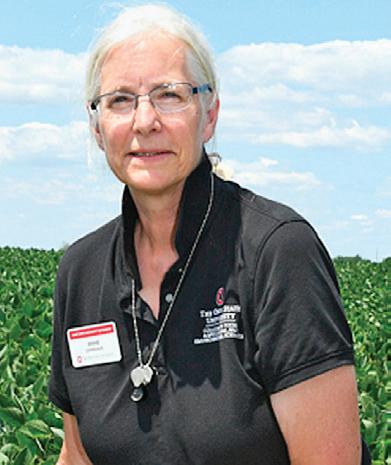
Anne Dorrance is working with checkoff-funded SCN Coalition to eliminate soybean cyst nematodes.











By Irene Gentzel
In the quest for high soybean yields, it may be tempting to tank mix an insecticide with a planned fungicide treatment for a single-pass application. After all, insecticide doesn’t cost much and mixing with another treatment could save a lot of time and wear and tear on the field.
“Insecticide is like a cheap insurance,” says Laura Lindsey, director of the Soybean and Small Grain Crop Agronomy Program at The Ohio State University. “But we don’t like blanket application because of resistance issues.” Lindsey, who is often asked by growers about this dual application, has been working on a checkoff-funded project to investigate the potential of this tankmixed insecticide to increase soybean yields. Her two-year project revealed that fungicide application at the R3 stage in late July did increase yields significantly during the 2015 season. This effect, however, was most likely due to higher disease incidence that year because “2015 was really, really wet,” she explains. Addition of an insecticide to the fungicide treatment, however, had no effect on soybean yields. Lindsey also found that her soybean fields were still prone to damage from insects like bean leaf beetles a month or two after application. Without long-lasting insect protection and no observed yield benefit, Lindsey determined that growers can enjoy a small cost savings by eliminating insecticide
Planting date: The earlier the better. Later plantings require higher seeding rates, which diminishes the crop’s economic return. Planting early also gives greater assurance the soybeans will be fully developed by harvest time.
Relative maturity groups: Choose wisely. The optimal RM group will have the longest vegetative stage possible to provide more branches for the flowering stage, while still reaching full maturity prior to the autumn frosts.
Row spacing: Narrow is best. In Ohio fields, narrow row spacing, i.e., 7.5 and 15-inches, resulted in higher yields compared to 30-inch rows commonly used in other states.
from their mid-season fungicide regimen. Despite the negative results on traditionally grown soybeans, Lindsey suspects tank mixed insecticide and fungicide may prove beneficial for double-crop systems. Double-crop soybeans, sometimes referred to as second-season soybeans, are planted immediately after a winter wheat or other small grain harvest in late spring. These soybeans, while planted late compared to traditional methods, still mature in time for the autumn harvest. However, the developmental differences in doublecropped soybeans, compared to the traditionally planted ones, can cause issues for growers. “When you have green
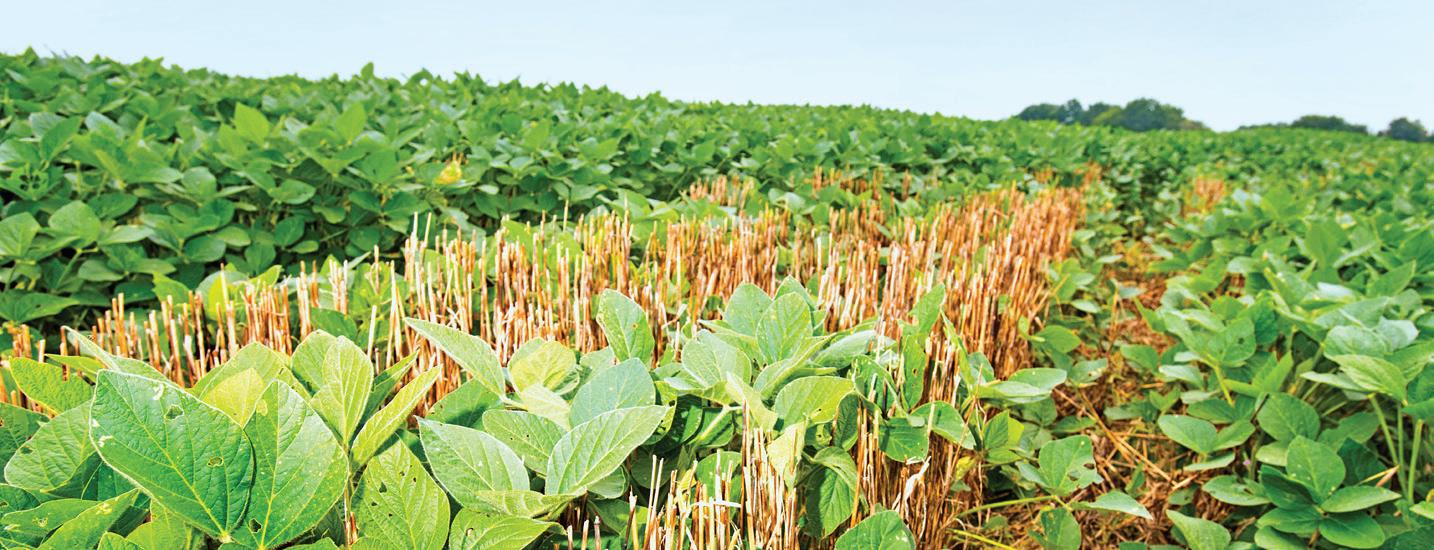
plants and everything else around them is dead, this attracts insects,” Lindsey notes. Double cropping is not especially common in Ohio. “Ohio is marginal. Growers south of I-70 usually can do a double crop, but above I-70 is more variable,” she explains. It can be a profitable endeavor, and Lindsey wants to help farmers establish conditions needed for high double-crop soybean yields. To do this, Lindsey’s checkoff-funded project examines the effects of planting date, soybean relative maturity, row spacing and seeding rate. Planting early is the most important factor for profitability, she determined, because “the later you plant, the higher seeding rates need to be.”
In this multiyear study, a seeding rate of 250,000 seeds/acre was necessary to achieve the highest partial economic return. Soybean relative maturity groups with maximal vegetative growing time prior to the reproductive stage are also key for high yields.
For more information on her doublecrop evaluations and other soybean projects, check out Dr. Lindsey’s website at https://bit.ly/2xYfNae

By Irene Gentzel
utrient management is an important aspect of soybean farming, because knowing when and how much of a fertilizer to apply is key to high yields. Growers strive to maintain healthy fields and at the same time reduce runoff to both minimize costs and adverse effects to the environment. This is especially the case for those in the Lake Erie region, where farmers have increased their nutrient best management efforts to curb algal blooms.
What’s lacking is a reliable method to assess these management practices state-wide.
To address this issue, John Fulton, a professor within the department of Food, Agricultural and Biological Engineering at The Ohio State University, has recently completed an OSC-funded pilot study to develop a database of information that showcases the success of Ohio farmers in their efforts to maintain water quality in the Lake Erie watershed and across the state. “The intent is to develop an annual report for Ohio agriculture — crops and livestock — that outlines voluntary adoption of BMPs (best management practices) that enhance nutrient management,” Fulton says.
Currently, the closest method Ohio has for an annual reporting system is the voluntary 4R certification program that nutrient retailers and service providers participate in. Fulton’s project similarly evaluated information from consultants and retailers, but also sought to gather even more specific data directly from Ohio farmers. This aspect of the project is unusual, even among nutrient management programs in other states. “Our ability to collect field-level information is somewhat unique as other states aren’t quite going to that resolution yet,” Fulton says.
The main purpose of Fulton’s study was to determine if field-level data could

Professor John Fulton is working to document Ohio farmers’ success in maintaining water quality across the state.
be accessed. Initially, some growers were concerned about confidentiality as well as the time and monetary costs of participation. “I think once you outline what it could do, it’s definitely a positive response,” Fulton explains. In addition to individual farmers, Fulton interviewed retailers and consultants to gather information on BMPs utilized across the state. Thanks to all the participants, the
In a Nutshell:
pilot project yielded useful information. “We were really able to line out what the potential is and what we could report out,” Fulton says.
With the pilot study complete, Fulton is now working with commodity groups to develop a state-wide voluntary reporting method. “There’s an interest to attempt to build a program that would help do this. The question is to be able to scale it to a level that represents what’s happening not only in the Lake Erie watershed, but in the future across Ohio. I think we’ve gotten insights to that, we understand there’s potentially some ways that could be done. And those are the discussions that are really just starting to begin. What are those next steps and how do we move forward and make something like this happen,” Fulton says.
Once fully implemented, the reporting program will give environmental policy makers an accurate representation of Ohio growers’ nutrient management success. u
Nutrient best management practices are being implemented by farmers all across Ohio, but methods to evaluate their overall success still need to be developed.
This pilot study gathered specific, field-level data from growers and retailers in a secure and confidential manner. This information was then aggregated to create a state-wide summary of nutrient BMPs.
Now that the researchers have confirmed that such data can be reliably collected, they are exploring options for developing a reporting program that facilitates more comprehensive analysis on an annual basis.
With an annual reporting method in place, policy makers will be better informed on the commitment Ohio’s agricultural community has for nutrient management.
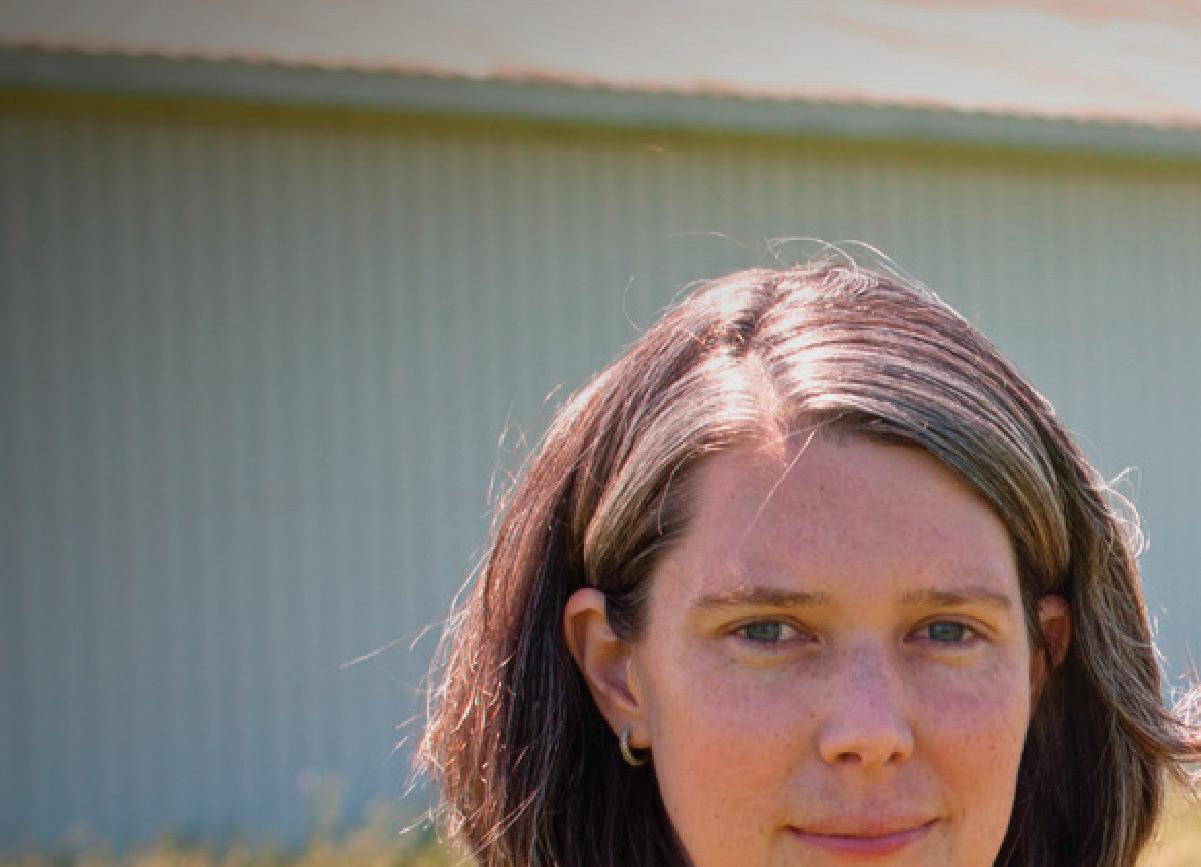





Meet the researcher whose applied soybean research program improves the bottom line of soybean farmers across Ohio. Dr. Laura Lindsey is an assistant professor of soybean and small grain production in the Department of Horticulture and Crop Science at The Ohio State University. She’s no stranger to the activities of the Ohio Soybean Council (OSC). From identifying yield-limiting factors to supporting graduate students’ quests to further the industry, she enjoys practical science and focuses on research that delivers direct value to our state’s soybean farmers. She is very appreciative of the support of OSC and the soybean checkoff that allows her to offer sound agronomic recommendations.
BROUGHT TO YOU BY OHIO SOYBEAN FARMERS AND THEIR CHECKOFF.


By Julia Brown
With the uncertainty tariffs have brought, now is a crucial time to start building new international markets and maintaining good relationships with current trade partners. In August and September, the Ohio Soybean Council (OSC) helped achieve both of those goals by hosting trade team visits with representatives from South Korea, Japan and China. The groups came to study and estimate yields, protein and other quality aspects of the year’s U.S. soy crop. They will use this information to
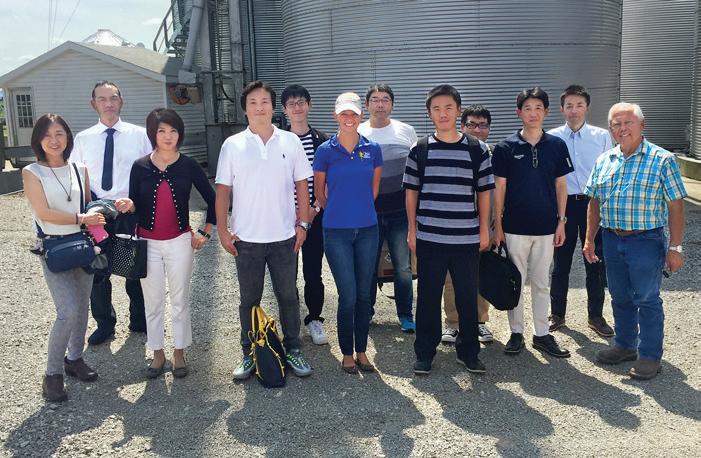


assist in the forecasting for their upcoming purchasing of food grade soybeans.
The visits were arranged by the U.S. Soybean Export Council (USSEC), whose mission is to maximize the use of U.S. soy internationally by meeting the needs of key stakeholders and global customers. According to USSEC, the trade team buyers have an interest in buying U.S. soy, regardless of the current tariff situation.
Bill Bayliss, OSC’s secretary and a soybean farmer from Logan County, hosted trade teams from South Korea and Japan. “I think the trade team visits are
great because buyers from other countries are able to put a face and a farm to the soybeans they buy,” he said.
“Ohio soybeans are consistently very high in quality and protein,” explained OSC Executive Director Kirk Merritt.
“These trade team visits offer a chance to show our global partners just how good they are.”
If you are interested in hosting a trade team on your farm, please contact Katie Bauer, OSC’s Global Demand and Market Development Coordinator, at kbauer@ soyohio.org u


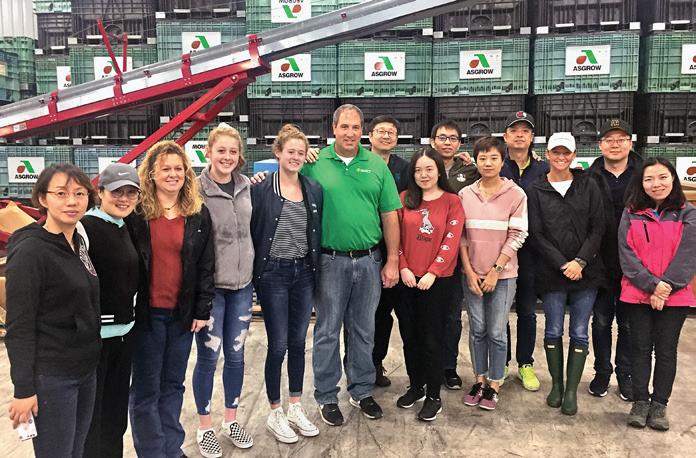

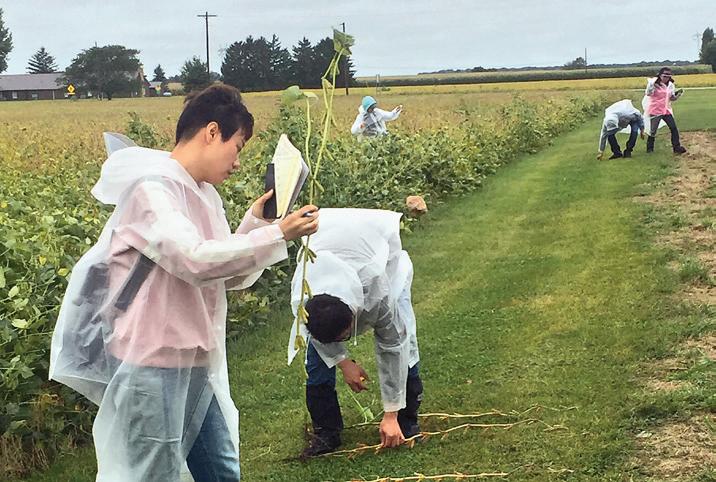



By Michael Gaynor
Ohio is home to the nation’s third largest rail network: 40 railroads operating over 4,903 track miles connect the Buckeye state’s 26,000 soybean farmers to U.S. and global markets day in, day out.
And believe it or not, the dozens of large and small freight railroads that operate across America’s 140,000-mile rail network are nearly all privately owned. That means they’re paying their own way — a point of departure from other transportation modes that utilize publicly funded roads and waterways.
So when soybeans and their byproducts travel via rail from one of the thousands of Ohio soybean farms and facilities to markets across the country and world, they move along a network that is built, maintained and operated by private dollars.
Like most infrastructure, the rail network requires massive spending. Class I freight railroads have collectively spent $100 billion over the last four years alone, with capital expenditures totaling six times that of the average U.S. manufacturer. Between maintenance and capex, this breaks down to 40 cents of every revenue dollar spent by railroads to enhance safety and efficiency.
This matters to Ohio’s soybean farmers because it means that railroads are constantly improving service and operations, working to move more for less.
Technological improvements, like advanced routing software, the use of big data and fuel management systems, have delivered remarkable results. Trains today can move a ton of freight 479 miles per gallon of fuel, double what was possible in 1980—and four times the efficiency of trucks. What’s more, rail rates have dropped 45 percent in this same time frame.
Shippers aren’t the only ones who benefit when private railroads invest.

Major railroads indirectly supported some 1.5 million jobs across the U.S. and their investments generated $274 billion in annual economic activity in 2014, according to research from Towson University. That means that for every dollar rail companies invest, $10 is produced across the U.S. economy.
Soybeans constitute 21 percent of rail’s grain carloads across the country. Beyond hauling the grains themselves, trains are crucial to the other aspects of agriculture, from the movement of products like finished farm equipment, to chemicals like anhydrous ammonia, potassium compounds and urea. They also carry millions of tons of raw materials used to produce fertilizer each year, including phosphate rock, crude potash and sulfur.
Soybeans and rail also share a deep connection to international trade. From 2007 to 2016, exports accounted for 45 percent of soybean use — with China as the single-largest foreign market. Railroads, which haul one-third of U.S. exports, similarly depend on interna-

tional trade. A recent report found that 50,000 rail jobs and 42 percent of rail carloads and intermodal units directly depend on trade.
Dating back to the 19th century, railroading in the Buckeye State was critical to its economic development. In the north, rail provided a connection to the Great Lakes, and in the south, Cincinnati once served as the rail hub of the nation. A lot has changed since the early days of statehood, but freight rail remains an economic driver and key partner to Ohio’s soybean farmers. u
Michael Gaynor is Assistant Vice President of Field Operations at GoRail, a national non-pro t promoting the bene ts of freight railroads.


By Julia Brown
The Ag Biotech Academy program, funded by Pioneer and Ohio soybean farmers and their checkoff through the Ohio Soybean Council (OSC), offers a chance for teachers to learn about the latest seed research, examine the impact of environmental issues and sustainability, participate in biology and chemistry labs, and hear from industry experts. It helps to achieve OSC’s goal to educate the next generation about modern agriculture and increase trust and understanding of agriculture among Ohio teachers and students.

Ag Biotech Academy has been held every summer since 2011. This year’s program was held June 26-27 at the Global Impact STEM Academy in Springfield, Ohio.
This year, teachers had the opportunity to evaluate the workshop through surveys conducted by Education Evaluation Specialists Melinda Lloyd, Ed.D., and Kerry Dixon, Ph.D. from The Ohio State University. Based on their estimates, for the 41 educators who participated in this year’s program, nearly 4,600 students will learn about soybeans and Ohio farmers this school year. If teachers continue to use the curriculum they learned for the next ten years, that would mean a potential impact of 46,000 students from this Ag Biotech Academy class alone. That reach will extend beyond Ohio as well — teachers came from 23 different counties throughout the state of Ohio, one county in Illinois, and one county in Maryland.
Overall, participants were pleased with their experience at Ag Biotech Academy, with 80 percent of them giving the total program a 5 out of 5, with 5 being the most favorable. “We’re really happy with the results of our evaluation,” said Tom Fontana, director of research and education at the Ohio
asked if they thought farmers prioritized issues like the environment, food safety and affordable food supplies.
Over the course of the workshop, teachers’ knowledge about biodiesel and food science increased the most, as did their comfort in teaching those topics. Teacher participants also intend

Soybean Council. “We are using farmer and industry resources to fund this program, so we want to make sure this is a good investment of checkoff dollars.” Fontana stressed that Ag Biotech Academy helps teachers make the connection between science and agriculture inside the classroom.
“Farmers feel it’s important to educate young people about modern agriculture. Ag Biotech Academy is designed to do just that, while making sure teachers have access to the resources they need to create trust and understanding of the industry,” he explained. And teachers do trust farmers — teacher participants gave an average score of 4.5 out of 5 when
Gina Lantz, a bioscience instructor at the Delaware Area Career Center, mixes up the ingredients to make soy flour tortillas.
to use the information they learned: for each of the topics included in the evaluation, teachers’ intention to teach those topics went up between the pre-workshop evaluations to the post-workshop evaluations.
“We plan to use the information and feedback from these evaluations to make the workshop even better and more useful for teachers,” Fontana said. “The better it is for teachers, the easier we can make educating the next generation about agriculture.” u



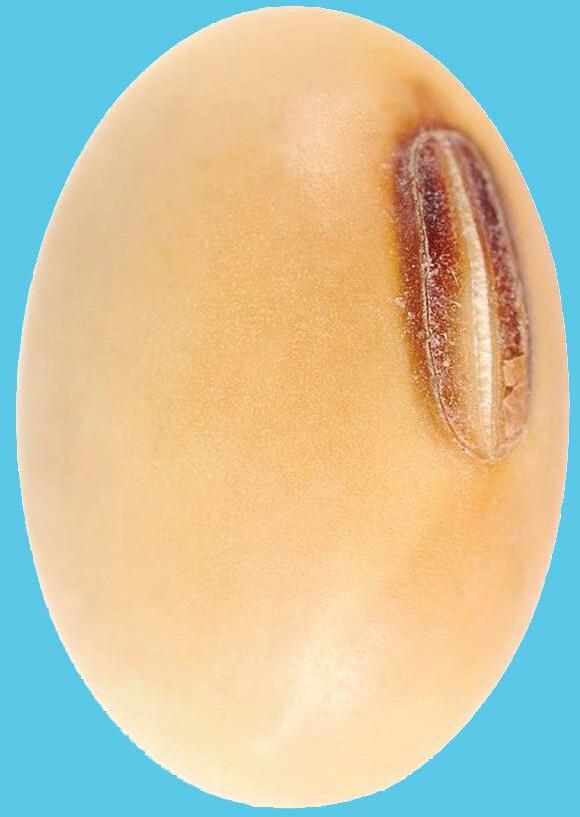

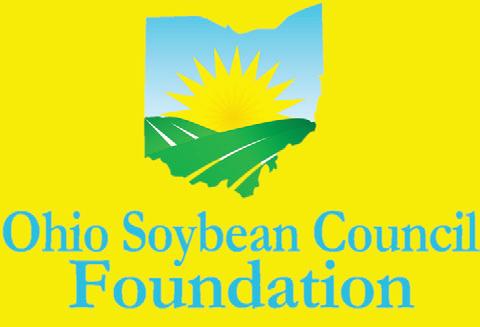


By Julia Brown
id you know that Ohio’s chickens and turkeys eat 16.2 million bushels of soybeans every year? You can make your Thanksgiving even more soy-friendly by using these recipes at your holiday table.

Courtesy of Genius Kitchen
INGREDIENTS
• 3⁄4 cup sugar
• 1 1⁄4 teaspoons ground cinnamon
• 1⁄2 teaspoon salt
• 1⁄4 teaspoon ground ginger
• 1⁄8 teaspoon ground nutmeg
• 1⁄8 teaspoon ground cloves
• 1 (15 ounce) can pumpkin
• 1 1⁄4 cups soymilk
• 2 large eggs
• 1 (9 inch) pie shell (store-bought or homemade, thawed if frozen)
DIRECTIONS
1. In a large bowl, mix sugar, cinnamon, salt, ginger, nutmeg, and cloves; add pumpkin, soy milk, and eggs; whisk until well blended.
2. Pour mixture into unbaked pastry.
3. Set pie on bottom rack of a 425°F oven; bake for 15
minutes, then reduce temperature to 350°F; continue baking until center of pie is set and a knife inserted in the middle comes out clean, about 45 minutes longer.
4. Set pie on a rack until cool to touch, at least 2 hours.
5. After serving, chill any remaining pie in an airtight container.
Courtesy of Taste of Home
INGREDIENTS
• 2 cups water
• 1 1⁄2 cups chicken broth
• 1 cup reduced-sodium soy sauce
• 2⁄3 cup lemon juice
• 2 garlic cloves, minced
• 1 1⁄2 teaspoons ground ginger
• 1 teaspoon pepper
• 2 large oven roasting bags
• 1 turkey (12 to 14 pounds)
DIRECTIONS
1. Combine the first seven ingredients; set aside and refrigerate 1 cup for basting. Place one oven roasting bag inside the other. Place turkey inside inner bag; pour in remaining marinade. Seal bags, pressing out as much air as possible; turn bag to coat turkey. Place in a shallow roasting pan. Refrigerate overnight, turning several times.
2. Remove turkey; drain and discard marinade.
3. Preheat oven to 325°.

Place turkey on a rack in a large roaster. Bake, uncovered, 3 to 3-1/2 hours or until a thermometer inserted in a thigh reads 170°. Baste frequently with reserved marinade. When turkey begins to brown, cover lightly with a tent of aluminum foil. Remove turkey from oven; tent with foil. Let stand 20 minutes before carving. If desired, skim fat and thicken pan drippings for gravy; serve with turkey. u


WORTHINGTON, Ohio – Light
Curable Coatings, a bio-preferred floor coating that was developed through funding from the Ohio Soybean Council (OSC) and Ohio soybean farmers’ checkoff, has been designated as a finalist for the 2018 R&D 100 Awards. Winners will be announced in November at the fourth annual R&D 100 conference. The R&D 100 Awards program honors the 100 most innovative technologies of the past year. Finalists were selected by an independent panel of more than 50 judges representing R&D leaders in a variety of fields. More information about the awards can be found here.
The coating is a UV-cured, high-performance, bio-preferred floor coating with no volatile organic compounds (VOCs). The clean, green soy-acylate-based product delivers exceptionally low cure times and meets or exceeds industry targets for appearance, hardness, adhesion, solvent resistance, and application temperature.
“As Ohio soybean farmers, we can be proud that our checkoff dollars are being used to make products that are worthy of prestigious recognition,” said Nathan Eckel, OSC Research Committee chair and soybean farmer from Wood County. “This kind of honor just goes to show how versatile soybeans can be.”
If Light Curable Coatings wins in November, it will be the ninth R&D 100 Award presented to OSC since 2002. For more information about Light Curable Coatings, OSC’s role in its development, or licensing, please contact Barry McGraw, OSC’s Director of Product Development & Commercialization, at bmcgraw@ soyohio.org or 614-476-3100. u


This year, the Ohio Soybean Council’s state fair booth had a few special visitors. Fourteen influencers, or social media users who have large audiences and established credibility, stopped by the booth to learn more about Ohio soybean farmers. The group has a combined social reach of 348,400 and shared at least 60 posts on social channels sharing positive information about GMOs, hormones in meat and tips to properly cook meat at home.

Jennifer Rome brought along her son Jeffrey, who seemed to really enjoy the virtual reality tour of the Ohio River.
The influencer tour was organized by Jennifer Osterholt, who runs her own blog “Plowing Through Life” about living and working on a farm. “Offering a special event for influencers allowed OSC to maximize their checkoff investment at the Ohio State Fair by reaching thousands of people online, who weren’t able to attend the fair, with key messages about modern agriculture,” she said. With GMO education, Osterholt wanted the influencers to learn how to approach food with critical thinking and not be afraid when they go to the grocery store. According to her blog post about the fair, Jennifer Rome of Why CLE wrote, “I typically think of fairs as being about rides, games, and fair food. While there is plenty of that at the Ohio State Fair, there is also the chance to learn more about Ohio’s agricultural com-
munity and support the farmers.”
Another blogger, Joe from 614ortyNiner wrote, “If the consumers want it, the farmers of this state are going to do their darn best to get it out there.” u

This Instagram post from Layla Helton of Layla Living shows how little the average consumer knows about soy, making blogger tours like these even more important.


By Julia Brown
The Ohio Soybean Council (OSC) invests soybean checkoff dollars into projects that help increase the usage of soybeans and bioproducts. Recently, OSC helped fund a National Biodiesel Board (NBB) project to expand the biodiesel market in locomotives.

biodiesel use above B5, or a diesel blend with five percent biodiesel. NBB is working to educate railroads, locomotive manufacturers and the Association of American Railroads about the benefits of higher blend biodiesel and encouraging them to make the switch to at least B20.

57 percent and up to 86 percent when compared to petroleum diesel.

Thanks to the investment of Ohio soybean farmers’ checkoff dollars, trains like these will soon run on higher blends of biodiesel, making Ohio soybeans more valuable.

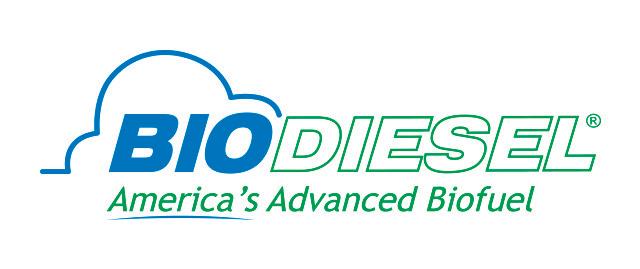
The vast majority of biodiesel is made of soybean oil, making it a crucial part of the soybean value chain, with the potential for high-volume demand. Demand for biodiesel is increasing because it is clean-burning, better for engine health and reduces the United States’ dependence on foreign oil. In fact, several federal and state laws mandate or encourage using biodiesel.
With these factors in mind, NBB has been working with the locomotive market to increase demand for higher blends of biodiesel fuels. Currently, most locomotive manufacturers will not warranty their products for
“Whether they want to fight it or not, policies across the country will be at a point where they will have to use B20,” said Scott Fenwick, technical director for NBB. His role at NBB includes ensuring there are no technical barriers for biodiesel to replace petroleum consumption wherever possible.
For Fenwick, the chance for railroads to use higher blends of biodiesel is mutually beneficial — soybean farmers benefit from an expanded market and railroads benefit by being able to market themselves as environmentally sustainable, with reduced soot and greenhouse gas emissions. Biodiesel is the first and only EPA-designated Advanced Biofuel in commercial-scale production across the country. As an Advanced Biofuel, biodiesel reduces greenhouse gas emissions by at least
“While biodiesel is great and has a lot of benefits, we want to make sure those benefits are tied back to U.S. farmers,” Fenwick said. “As we expand the biodiesel industry here in the U.S., we start to reduce the need to export as many soybeans elsewhere.” Simultaneously, however, countries like Indonesia and India are pushing to use B30 biodiesel, meaning that biodiesel made from U.S. soybeans is in demand across the globe.
“It really comes full circle when you think about it: soybeans need trains for transportation and trains can use soybeans in the form of biodiesel for fuel,” said Tom Fontana, director of research and education for OSC. “Plus, locomotives and railroads could be an important market for biodiesel, which means increased demand for soybeans for our Ohio farmers.”
“Farmers in Ohio should be proud of the work that they’re doing to help expand the biodiesel industry. These increasing volumes that we’re pushing for in the locomotive industry are certainly going to demand more soybean oil,” Fenwick explained. “Soybean farmers are poised to really take advantage of all of that.” u
